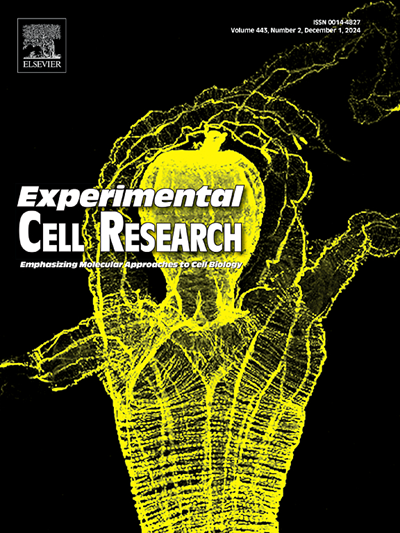Estrogen receptor activates SRC and ERK1/2 and promotes tumorigenesis in human testicular embryonic carcinoma cells NT2/D1
IF 3.3
3区 生物学
Q3 CELL BIOLOGY
引用次数: 0
Abstract
Testicular germ cell tumors have the highest incidence in young men (between 15 and 44 years of age) and its etiology is still unclear, but its emergence on puberty suggests a hormone-dependent mechanism for the development of these tumors and their progression. We previously identified the estrogen receptor ESR1, ESR2, GPER and an isoform of ESR1, the ESR1-36 in human testicular embryonic carcinoma NT2/D1 cells, and the activation of SRC induced by ESR1 and ESR2 in these cells. Therefore, this study aimed to analyze the role of ER in the activation of ERK1/2, and the involvement of SRC and ERK1/2 on proliferation, migration, and invasion of the NT2/D1 cells. Our results showed that the activation of ESR1 (using ESR1-selective agonist PPT) or ESR2 (using ESR2-selective agonist DPN) increased phosphorylation of ERK1/2 in NT2/D1 cells. In the presence of the selective inhibitor for SRC-family kinases PP2, or the MEK specific inhibitor U0126, the effects of 17β-estradiol (E2) or PPT were blocked on proliferation and invasion of NT2/D1 cells. Finally, the proliferation, migration, and invasion of NT2/D1 cells simulated by E2 or ESR2 were also blocked by PP2 and U0126. This study provides novel insights into molecular mechanisms of ER in NT2/D1 cells by demonstrating that ER activates rapid responses molecules, including SRC and ERK1/2, which enhance the tumorigenic potential of testicular cancer cells.
雌激素受体激活 SRC 和 ERK1/2,促进人类睾丸胚胎癌细胞 NT2/D1 的肿瘤发生
睾丸生殖细胞瘤在年轻男性(15 至 44 岁)中发病率最高,其病因尚不清楚,但它在青春期出现表明这些肿瘤的发生和发展有激素依赖机制。此前,我们在人类睾丸胚胎癌 NT2/D1 细胞中发现了雌激素受体 ESR1、ESR2、GPER 和 ESR1 的异构体 ESR1-36,以及 ESR1 和 ESR2 在这些细胞中诱导的 SRC 激活。因此,本研究旨在分析ER在ERK1/2活化中的作用,以及SRC和ERK1/2对NT2/D1细胞增殖、迁移和侵袭的参与。结果表明,激活 ESR1(使用 ESR1 选择性激动剂 PPT)或 ESR2(使用 ESR2 选择性激动剂 DPN)会增加 NT2/D1 细胞中 ERK1/2 的磷酸化。在 SRC 家族激酶选择性抑制剂 PP2 或 MEK 特异性抑制剂 U0126 的存在下,17β-雌二醇(E2)或 PPT 对 NT2/D1 细胞增殖和侵袭的影响被阻断。最后,PP2 和 U0126 也阻断了 E2 或 ESR2 对 NT2/D1 细胞增殖、迁移和侵袭的模拟作用。这项研究通过证明ER激活了包括SRC和ERK1/2在内的快速反应分子,从而增强了睾丸癌细胞的致瘤潜能,为ER在NT2/D1细胞中的分子机制提供了新的见解。
本文章由计算机程序翻译,如有差异,请以英文原文为准。
求助全文
约1分钟内获得全文
求助全文
来源期刊

Experimental cell research
医学-细胞生物学
CiteScore
7.20
自引率
0.00%
发文量
295
审稿时长
30 days
期刊介绍:
Our scope includes but is not limited to areas such as: Chromosome biology; Chromatin and epigenetics; DNA repair; Gene regulation; Nuclear import-export; RNA processing; Non-coding RNAs; Organelle biology; The cytoskeleton; Intracellular trafficking; Cell-cell and cell-matrix interactions; Cell motility and migration; Cell proliferation; Cellular differentiation; Signal transduction; Programmed cell death.
 求助内容:
求助内容: 应助结果提醒方式:
应助结果提醒方式:


